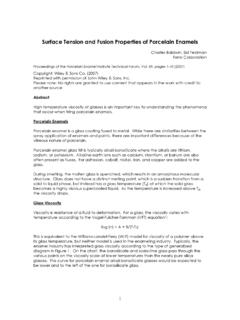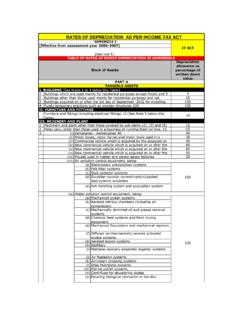Transcription of Porcelain (Vitreous) Enamels and Industrial …
1 Porcelain ( vitreous ) Enamels and Industrial enamelling processes William D. Faust*, Aurora, Ohio USA Abstract Porcelain ( vitreous ) Enamels and Industrial enamelling processes is a comprehensive book for the researcher, engineer and technician involved in the development and application of Porcelain Enamels in a wide range of systems. This volume, updated and expanded from the original Porcelain Enamels by A. I. Andrews in the USA, covers the scientific basis for glass formulation from the molecular level to raw material choices and their combinations to create useful materials for coating various metals. Properties of enamel (glass) systems are extensively discussed regarding thermal expansion, density, elasticity, thermal conductivity, colour, optical and appearance properties and other characteristics critical for successful development. Metal choices and pre-treatments are reviewed in depth for steel, cast iron, stainless steels, various alloys and aluminium as well as the machinery and materials needed to accomplish these vital processes .
2 Up-to-date information is included on metal chemistry, forming and welding technology. Manufacturing of Enamels is extensively covered from weighing, mixing, smelting and milling. Detailed information on smelters and mills is included highlighting developments since the advent of electrostatic dry powder enamel application. Application of Enamels by producers of finished products is discussed for wet, dry and various two coat one fire methodologies which have been developed in recent years. The physical, chemical, mechanical, and electrical properties of enamelled products are extensively covered along with references to national standards worldwide. Appendices include various national standards, troubleshooting cause-and-effect diagrams, an Atlas of enamel Defects with a wide range of visual illustrations, methodologies of fishscale testing, various technical data sheets and a glossary of enamelling terms.
3 This new book is a collaborator effort of many individuals associated with the enamelling industry throughout the world. It is a useful addition for academic institutions, research and development laboratories and manufacturing companies for reference and instruction. Introduction The goal of the current efforts of this new book is to disseminate Porcelain ( vitreous ) enamel technology and increase the focus on its value and uniqueness. This new book builds on the 1961 publication Porcelain Enamels by A. I. Andrews with expanded sections to support scientific concepts in order improve their understanding. Of special note is the enhanced discussion of the chemistry of steel and adherence of Porcelain ( vitreous ) Enamels to aid those involved in industry and research regarding enamelling technology. Porcelain Enamels continue to be a remarkable coating for steel and other metals.
4 During the last several decades, new formulations and methods have provided for commercially economical and desirable enamelled products. No nickel-no pickle ground coats have provided means of 2 meeting ecological directives and at the same time improving the efficiency of enamelling operations without regard the volume of production. Electrostatic powders and electrophoretic application have additionally remade the industry while reducing material, labour and production costs. Today, these new materials and processes are the norm and we look forward to new innovations. Porcelain ( vitreous ) Enamels provides an up-to-date and thorough compilation of materials, methods of smelting, application, firing and testing while providing fundamental understanding of the processes involved with better and larger details of Porcelain enamel chemical and physical properties to enhance the value for many applications such as drinking water, solar energy and coatings on various metals and alloys.
5 Key information on modern steels is provided as well as welding which is important for many sheet steel products. Over the last several decades, the manufacture of steel has been revolutionised by continuous casting which has changed the chemistry of steel and improved their quality. New sources of information in the Appendices are included. They are Porcelain ( vitreous ) enamel Standards This is a compilation of standards including ISO, EN, ASTM, UNI, DIN, BS and AFNOR. The appendix provided a comprehensive table of equivalents for rapid identification. Standardisation of testing will continue to be of key importance regarding Enamels on metal and rationalisation of standards worldwide will improve their acceptance and promotion. Ishikawa s Cause and Effect Diagrams and Atlas of enamel and enamelling Defects - This appendix provides an easy and rapid method of identifying many enamelling problems, their causes and possible remedies.
6 The Atlas of enamel and enamelling Defects is an excellent visual aid, originally developed by the Institute of vitreous Enamellers and augmented with some additional resources. Fishscale Measurement Fishscaling has been a challenging problem for many years in the enamelling of various types of steel. New methods have been devised to characterize steels by direct testing and indirect methods such as permeation of hydrogen. Porcelain ( vitreous ) enamel Technical Data Sheet and Metrics and Metric Units Conversion Tables Both metric and English units of measure have been used throughout the book. Some technician and researchers find that both units are meaningful and may be used in one locality or another. This appendix provides numerous important factors and measurements. Glossary of enamelling Terms Each technology has its own terminology and enamellers are not exception.
7 A listing of many new and traditional terms is included in a definition format to aid in the understanding of the terms. Burner Technology - New specialised burners with integral heat exchangers are illustrated and their efficiencies compared. 3 Highlights of the Book and New Technology Electrostatic Powders enamelling processes have evolved greatly in recent years, building on previous developments. A key new area is electrostatic application of Enamels using powder spraying equipment. Modification of the surfaces of enamel frit particles has been accomplished by the use of a variety of reactive silicone compounds which react with the surface hydroxyls on the particles. This has allowed the development of high surface resistivity needed to hold an electrostatic charge. Application of the electrostatic powders was successfully adapted from equipment developed for organic powders and modified to handle the abrasive nature of glass.
8 Figure 1 illustrates the application of Porcelain ( vitreous ) enamel powders. A wide variety of finish coats and ground coats are now routinely applied with this methodology. There are limitations on the colour of Enamels which with wet methodology have pigments used for various colours. Due to the charge to mass ratio which is important with the electrostatic process, pigments tends to separate and selective deposit on points of high electrical potential such as edges and corners of target pieces. Figure 1 Schematic of Powder Application System. Smalto Porcellanato, Figure 1-Smaltura elettrosttica a polveri:gli impianti, September-December 2000, page 159. Development of the equipment needed to efficient application and very high material utilisation occurred over a period of a couple of decades. Continuing improvements are being made by equipment manufacturers to continue the progress made to date.
9 The electrostatic application process reduced the material usage, energy needed to apply the frit powder coating and less overall labour to achieve the same level of production as conventional wet processes . The basic components are of a fluidized bed: venturi pump system, applicator (gun) with one or more high voltage antennas, an application cabin or booth, an overspray collection system with primary and secondary air filters, and a powder return apparatus for recycling overspray. An important feature of the electrostatic powders is their particle size distribution which needs to be controlled initially as a virgin powder and then as a mix of virgin and recycled powder to achieve steady state conditions as much as possible. The fluidization of the powder and its subsequent density can affect application performance. Cold (low temperature) powders will not fluidize well 4 and hot powders will tend to over-fluidize.
10 All these conditions affect the spraying performance as shown in Figure 2. Powder Too Cold Powder Too Hot Powder Too Humid Too High Fluidisation Pressure Figure 2. Influence of Air Fluidisation and Fluidity on Spraying. Metal and Metal Preparation Continuously cast steel which are generally aluminium killed are nearly universal and various grades have replaced traditional types such as cold-rolled, enamelling iron and low carbon steels. The performance of these new steels is as good as traditional types and the quality is better (cleaner metal chemistry).





![Depreciation Table [See Rule 5] (Rates changed …](/cache/preview/d/9/a/7/7/f/e/6/thumb-d9a77fe6deaa3fa3b8e32afa58d2c060.jpg)
